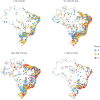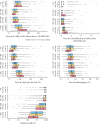Performance evaluation of tuberculosis control in Brazilian municipalities
- PMID: 35703607
- PMCID: PMC9239336
- DOI: 10.11606/s1518-8787.2022056004020
Performance evaluation of tuberculosis control in Brazilian municipalities
Abstract
Objective: To evaluate the performance of tuberculosis control in Brazilian municipalities.
Methods: This is an ecological study on Brazilian municipalities that notified at least four new cases of tuberculosis, with a minimum of one new case of pulmonary tuberculosis between 2015 and 2018. The municipalities were stratified according to the population in < 50 thousand, 50-100 thousand, 100-300 thousand, and > 300 thousand inhabitants, and the k-means method was used to group them within each population range according to the performance of six indicators of the disease.
Results: A total of 2,845 Brazilian municipalities were included, comprising 98.5% (208,007/211,174) of new tuberculosis cases in the period. For each population range, three groups (A, B, and C) of municipalities were identified according to the performance of the indicators: A, the most satisfactory; B, the intermediates; and C, the least satisfactory. Municipalities in group A with < 100 thousand inhabitants presented results above the targets for laboratory confirmation (≥ 72%), abandonment (≤ 5%), and cure (≥ 90%), and comprised 2% of new cases of the disease. Conversely, municipalities of groups B and C presented at least five indicators with results below the targets - HIV testing (< 100%), contact investigation (< 90%), directly observed therapy (< 90%), abandonment (> 5%), and cure (< 90%) -, and corresponded to 66.7% of new cases of tuberculosis. In group C of municipalities with > 300 thousand inhabitants, which included 19 of the 27 capitals and 43.1% of new cases of tuberculosis, the lowest percentages of contact investigation (mean = 56.4%) and directly observed therapy (mean = 15.4%) were verified, in addition to high abandonment (mean = 13.9%) and low coverage of primary health care (mean = 66.0%).
Conclusions: Most new cases of tuberculosis occurred in municipalities with unsatisfactory performance for disease control. Expanding the coverage of primary health care in these places can reduce abandonment and increase the contact investigation and directly observed therapy.
OBJETIVO: Avaliar o desempenho no controle da tuberculose dos municípios brasileiros.
MÉTODOS: Estudo ecológico com municípios brasileiros que notificaram pelo menos quatro casos novos de tuberculose, com no mínimo um caso novo de tuberculose pulmonar entre 2015 e 2018. Os municípios foram estratificados de acordo com a população em < 50 mil, 50–100 mil, 100–300 mil e > 300 mil habitantes e foi utilizado o método k-médias para agrupá-los dentro de cada faixa populacional segundo desempenho de seis indicadores da doença.
RESULTADOS: Foram incluídos 2.845 municípios brasileiros abrangendo 98,5% (208.007/211.174) dos casos novos de tuberculose do período. Para cada faixa populacional identificou-se três grupos (A, B e C) de municípios segundo desempenho dos indicadores: A os mais satisfatórios, B os intermediários e C os menos satisfatórios. Municípios do grupo A com < 100 mil habitantes apresentaram resultados acima das metas para confirmação laboratorial (≥ 72%), abandono (≤ 5%) e cura (≥ 90%), e abrangeram 2% dos casos novos da doença. Por outro lado, os municípios dos grupos B e C apresentaram pelo menos cinco indicadores com resultados abaixo das metas – testagem HIV (< 100%), exame de contatos (< 90%), tratamento diretamente observado (< 90%), abandono (> 5%) e cura (< 90%) –, e corresponderam a 66,7% dos casos novos de tuberculose. Já no grupo C dos municípios com > 300 mil habitantes, que incluiu 19 das 27 capitais e 43,1% dos casos novos de tuberculose, encontrou-se os menores percentuais de exames de contatos (média = 56,4%) e tratamento diretamente observado (média = 15,4%), elevado abandono (média = 13,9%) e baixa cobertura da atenção básica (média = 66,0%).
CONCLUSÕES: Grande parte dos casos novos de tuberculose ocorreu em municípios com desempenho insatisfatório para o controle da doença, onde expandir a cobertura da atenção básica pode reduzir o abandono e elevar o exame de contatos e tratamento diretamente observado.
Conflict of interest statement
Figures






References
-
- World health Organization. WHO global lists of high burden countries for TB, multidrug/rifampicin-resistant TB (MDR/RR-TB) and TB/HIV, 2021-2025. Geneva (CH): WHO; 2021 [cited 2021 Jun 17]. Available from: https://www.who.int/news/item/17-06-2021-who-releases-new-global-lists-o...
-
- Ministério da Saúde (BR), Secretaria de Vigilância em Saúde, Departamento de Doenças de Condições Crônicas e Infecções Sexualmente Transmissíveis, Coordenação Geral de Vigilância das Doenças de Transmissão Respiratória de Condições Crônicas. Bol Epidemiol Tuberculose; 2021 [cited 2021 May 12]; N° Espec. http://www.aids.gov.br/pt-br/pub/2021/boletim-tuberculose-2021
-
- Ministério da Saúde (BR). Secretaria de Vigilância em Saúde. Departamento de Vigilância das Doenças Transmissíveis. Brasil Livre da Tuberculose: Plano Nacional pelo Fim da Tuberculose como Problema de Saúde Pública. Brasília (DF); 2017. Available from: http://bvsms.saude.gov.br/bvs/publicacoes/brasil_livre_tuberculose_plano...
-
- Barreto ML, Rasella D, Machado DB, Aquino R, Lima D, Garcia LP, et al. Monitoring and evaluating progress towards Universal Health Coverage in Brazil. PLoS Med. 2014;11(9):e1001692. https://doi:10.1371/journal.pmed.1001692 - DOI - PMC - PubMed
-
- Ministério da Saúde (BR), Secretaria de Vigilância em Saúde. Indicadores prioritários para o monitoramento do Plano Nacional pelo Fim da Tuberculose como Problema de Saúde Pública no Brasil. Bol Epidemiol. 2017;48(8):1-11.
MeSH terms
LinkOut - more resources
Full Text Sources
Medical

